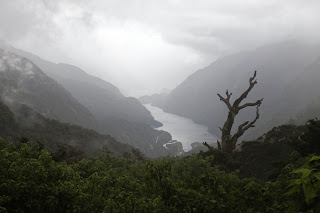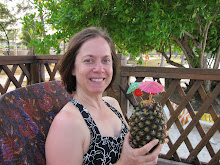New Zealand was a country on my travel "bucket list". After seeing the Lord of the Rings Trilogy and knowing the filming was done in NZ my desire to visit NZ increased. When we moved to Singapore we made a list of where we wanted to go while living on the other side of the world, NZ came up high on the list. Now, if you look at the globe or an atlas you will realize NZ is not really close to anywhere, even Australia. Our direct flight from Singapore was a shocking 9 1/2 hour flight!
We left on December 20th and returned to Singapore on January 5th, allowing 17 days. Our travel agent convinced us that 17 days was really only enough to see one island, so we concentrated on the South island. Our trip began in Queenstown.
Day 1 - was a visit to the Walter Peak Farm across Lake Wakatipu from Queenstown. This was one of the things I wanted to do, visit a working sheep farm. Everyone enjoyed the demonstrations of the border collie herding the sheep and the sheep shearing.
Day 2 - 4 - We headed to Te Anau for a 3 day hike on the Hollyford Track. This was a hike through a rain forest in the Fiordlands. Eric and I had never hiked with a pack so I knew this trip would be a challenge, the first day was a 17 k hike, with pack and it rained ALL day. I'm sure the rain forest was lovely but my head was down most of the day watching where I stepped so I did not see much of it. Days 2 and 3 saw bits and moments with no rain but as Peter said "It is a rain forest and they measure annual rainfall here in meters!". Enough said. The highlight of this trip was the flight at the end over beautiful Milford Sound and the food.
 |
| Milford Sound from a small plane. |
 |
| View of the Fiordlands, typical for us it was raining. |
Day 10 - We headed up the West coast to see Fox Glacier and Franz Josef Glacier. Our hike on Fox Glacier was canceled due to avalanches caused by - the rain! The scenery along the west coast was gorgeous and the drive incredible and we had sunshine from this point on. They don't have straight roads in NZ, the roads are super winding.
Day 11 - We headed up farther north along the West coast to Hokitika. Hokitika is a neat little town, full of good food and lots of stores that sell Green Stone (NZ Jade). Our lodging had the most incredible view over the Hokitika valley. While in Hokitika we visited the National Kiwi Centre, seeing a Kiwi in the wild is nearly impossible. They are nocturnal and endangered and a very odd looking bird! While wandering around the town we found a sock museum, full of many old sock knitting machines. The lady who owns the shop is the only person who still makes sock knitting machines and she hosts sock knitting machine conferences every summer in the US, who knew?
 |
| West Coat near Cape Foulwind. |
 |
| Pancake Rocks |
 Day 15-16 - As we left Nelson and headed to the East coast of the island the scenery began to change dramatically. It was still spectacular but the mountains were more rounded and there were fewer trees less vegetation overall. We headed to Kaikoura, the bay off of Kaikoura is home to thousands of dusky dolphins and sperm whales year round, due to an abundance of nutrients in the deep underwater caverns and few predators for the dolphins. We did a dolphin encounter, Peter and Katy donned wet suits and actually swam with the dolphins and Eric and I happily watched from the boat and took pictures. We went whale watching in the afternoon, after seeing hundreds of dolphins a couple lazy sperm whale coming up for a breath then going back underwater was not very exciting! The dolphin encounter was by far the highlight of the trip for all 4 of us!
Day 15-16 - As we left Nelson and headed to the East coast of the island the scenery began to change dramatically. It was still spectacular but the mountains were more rounded and there were fewer trees less vegetation overall. We headed to Kaikoura, the bay off of Kaikoura is home to thousands of dusky dolphins and sperm whales year round, due to an abundance of nutrients in the deep underwater caverns and few predators for the dolphins. We did a dolphin encounter, Peter and Katy donned wet suits and actually swam with the dolphins and Eric and I happily watched from the boat and took pictures. We went whale watching in the afternoon, after seeing hundreds of dolphins a couple lazy sperm whale coming up for a breath then going back underwater was not very exciting! The dolphin encounter was by far the highlight of the trip for all 4 of us!Day 17 - Our last day in NZ and we are all pretty well pooped. We headed to Christchurch, we stayed at a hotel across the street from Christchurch Cathedral. We walked around the downtown area wandering in and out of shops and stopped to listen to street musicians, a low key end to the trip. We did see some buildings closed due to the earthquake there in the fall of 2010.
So, this was not a weaving or textile trip but I could not resist sharing the trip on the blog. The biggest surprise for us was the lack of mammals in NZ. We learned a lot on the Hollyford hike about the vegetation and lack of mamals and more on our Golden Bay tour. Basically the only indigneous mammal in NZ is a bat! Because of the lack of mammals there were no predators for the birds thus the evolution of the odd flightless birds found in NZ. Due to the introduction of mammals by man NZ has had some problems, everytime they introduce an animal it quickly overpopulates due to the lack of natural predators. My reason for explaining this is to share about their current problem, the Australian possum. Now, this possum does not look like the US possum, it has fur. The possum eats one ton of vegetation each night, I swear this is what we were told numerous times. So, now they catch and kill the possums then pluck their fur. The fur is then mixed with merino wool and sometimes silk for an incredibly soft, lightweight fiber. I never saw yarn for sale just the finished items.
 |
| Lots and lots of sheep but not millions.... |
We had a wonderful trip, New Zealand has incredible natural beauty and is an intersting place to visit. Oh, did I mention the food was yummy!
Now to get my looms threaded and get back to weaving!




















































